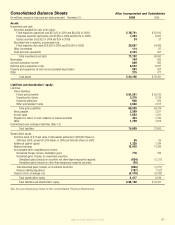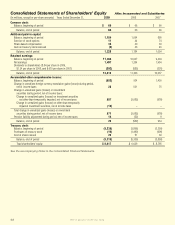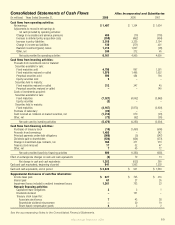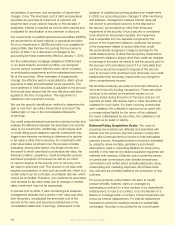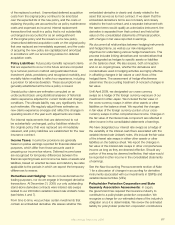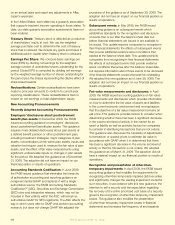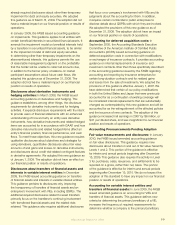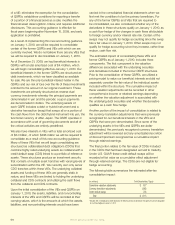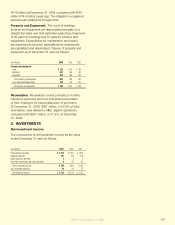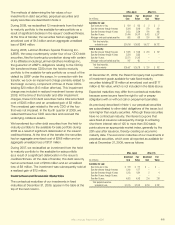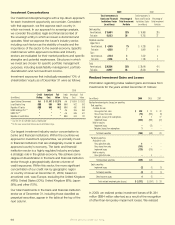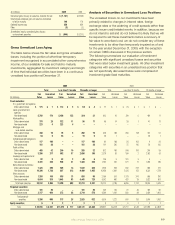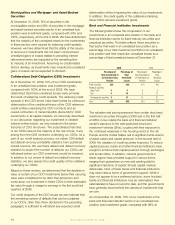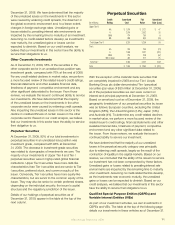Aflac 2009 Annual Report Download - page 65
Download and view the complete annual report
Please find page 65 of the 2009 Aflac annual report below. You can navigate through the pages in the report by either clicking on the pages listed below, or by using the keyword search tool below to find specific information within the annual report.
For additional information concerning our investments in
QSPEs and VIEs, see Note 3.
SEC Guidance
On October 14, 2008, the SEC issued a letter to the
FASB addressing questions raised by various interested
parties regarding declines in the fair value of perpetual
preferred securities, or so-called “hybrid securities,” and the
assessment of those declines under existing accounting
guidelines for other-than-temporary impairments. In its
letter, the SEC recognized that hybrid securities are often
structured in equity form but generally possess signicant
debt-like characteristics. The SEC also recognized that
existing accounting guidance does not specically address
the impact, if any, of the debt-like characteristics of these
hybrid securities on the assessment of other-than-temporary
impairments.
After consultation with and concurrence of the FASB staff,
the SEC concluded that it will not object to the use of an
other-than-temporary impairment model that considers
the debt-like characteristics of hybrid securities (including
the anticipated recovery period), provided there has been
no evidence of a deterioration in credit of the issuer (for
example, a decline in the cash ows from holding the
investment or a downgrade of the rating of the security
below investment grade), in lings after the date of its letter
until the matter can be addressed further by the FASB.
We maintain investments in subordinated nancial
instruments, or hybrid securities. Within this class of
investments, we own perpetual securities. These perpetual
securities are subordinated to other debt obligations of the
issuer, but rank higher than the issuers’ equity securities.
Perpetual securities have characteristics of both debt and
equity investments, along with unique features that create
economic maturity dates for the securities. Although
perpetual securities have no contractual maturity date,
they have stated interest coupons that were xed at their
issuance and subsequently change to a oating short-
term rate of interest of 125 to more than 300 basis points
above an appropriate market index, generally by the 25th
year after issuance. We believe this interest step-up penalty
has the effect of creating an economic maturity date for
our perpetual securities. We accounted for and reported
perpetual securities as debt securities and classied them
as both available-for-sale and held-to-maturity securities until
the third quarter of 2008.
We concluded in the third quarter of 2008 that all of our
investments in perpetual securities should be classied as
available-for-sale securities. We also concluded that our
perpetual securities should be evaluated for other-than-
temporary impairments using an equity security impairment
model for periods prior to June 30, 2008, as opposed to
our previous policy of using a debt security impairment
model. We recognized realized investment losses of $294
million ($191 million after-tax) in the third quarter of 2008
as a result of applying our equity impairment model to this
class of securities through June 30, 2008. Included in the
$191 million other-than-temporary impairment charge is $40
million, $53 million, $50 million, and $38 million, net of tax,
that relate to the years ended December 31, 2007, 2006,
2005 and 2004, respectively; and, $10 million, net of tax,
that relates to the quarter ended June 30, 2008. There were
no impairment charges related to the perpetual securities
in the rst quarter of 2008. The impact of classifying all
of our perpetual securities as available-for-sale securities
and assessing them for other-than-temporary impairments
under our equity impairment model was determined to be
immaterial to our results of operations and nancial position
for any previously reported period. Consistent with the
previously mentioned SEC letter regarding the appropriate
impairment model for hybrid securities, we have applied our
debt security impairment model to our perpetual securities
in periods subsequent to June 30, 2008, with the exception
of certain securities that are rated below investment
grade and are therefore being evaluated under our equity
impairment model. We will continue with this approach
pending further guidance from the SEC or the FASB.
Recent accounting guidance not discussed above is not
applicable or did not have an impact to our business.
2. BUSINESS SEGMENT AND FOREIGN
INFORMATION
The Company consists of two reportable insurance
business segments: Aac Japan and Aac U.S., both
of which sell supplemental health and life insurance. As
discussed in Note 1, in the fourth quarter of 2009 we
purchased CAIG which includes its wholly owned subsidiary
CAIC. CAIC is included in the Aac U.S. business segment
effective October 1, 2009.
Operating business segments that are not individually
reportable are included in the “Other business segments”
category. We do not allocate corporate overhead expenses
to business segments. We evaluate and manage our
business segments using a nancial performance measure
called pretax operating earnings. Our denition of operating
earnings excludes the following items from net earnings
on an after-tax basis: realized investment gains/losses, the
impact from ASC 815 (formerly referred to as SFAS 133), and
nonrecurring items. We then exclude income taxes related to
operations to arrive at pretax operating earnings. Information
regarding operations by segment for the years ended
December 31 appears in the tables on the following page.
Aflac Annual Report for 2009 61


